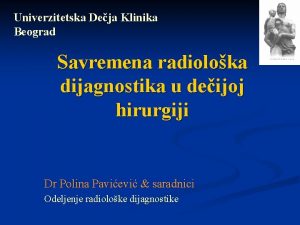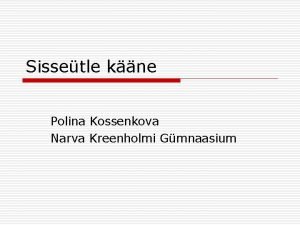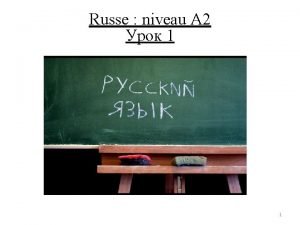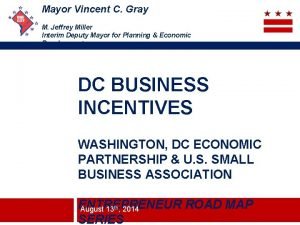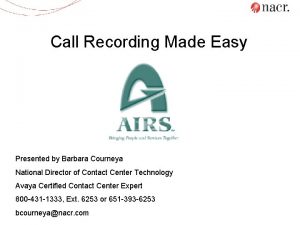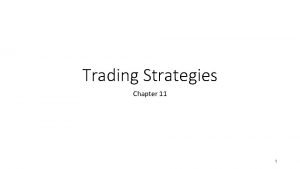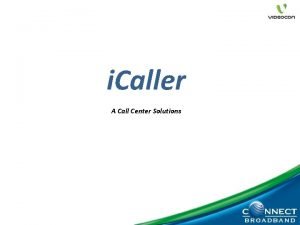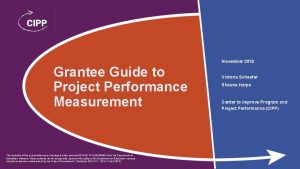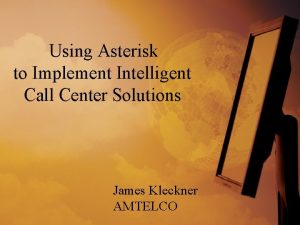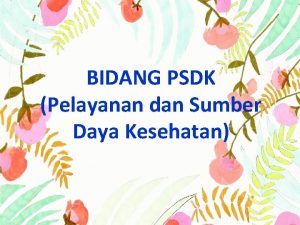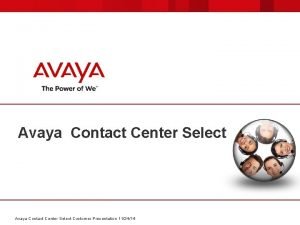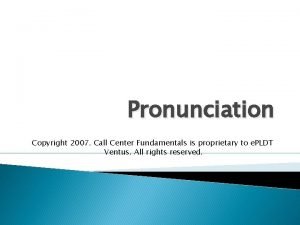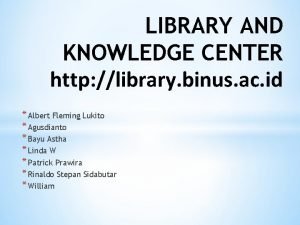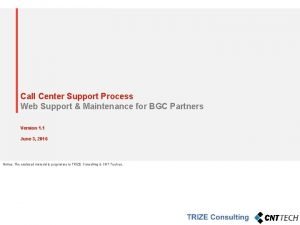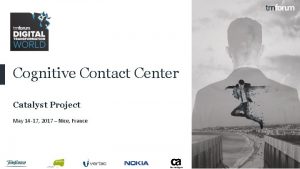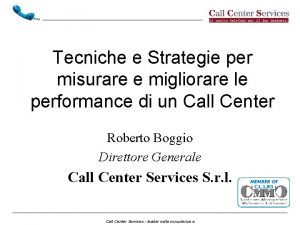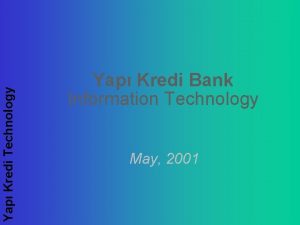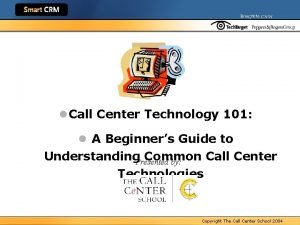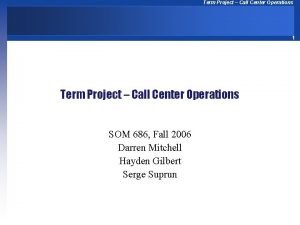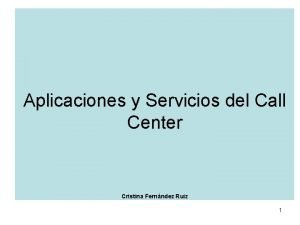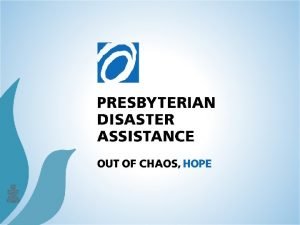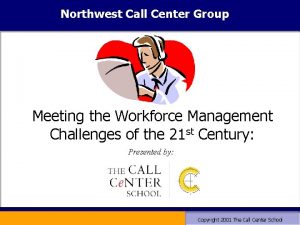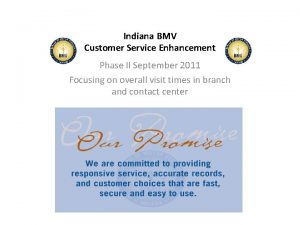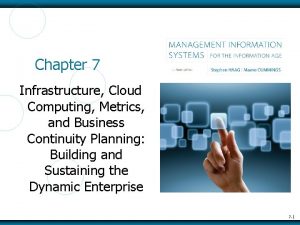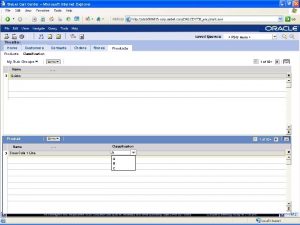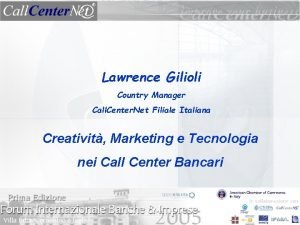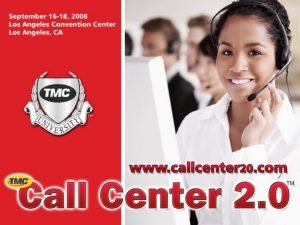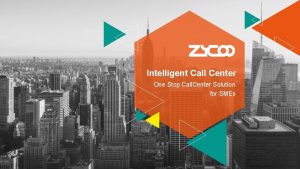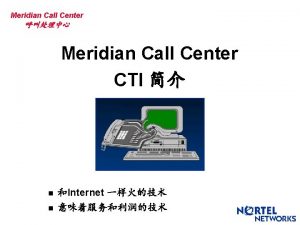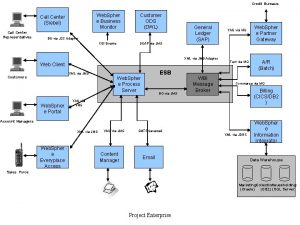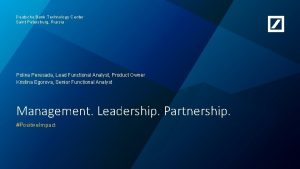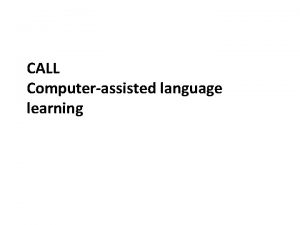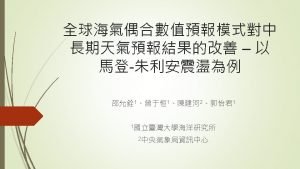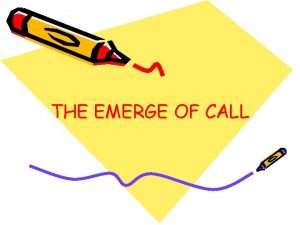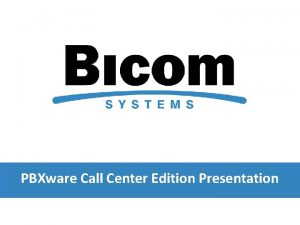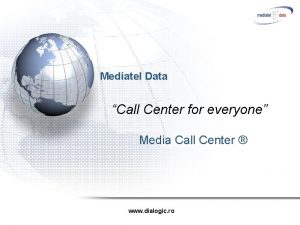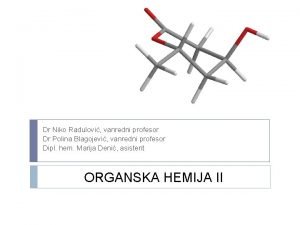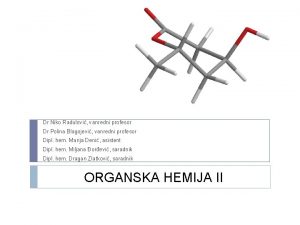Khudyakov Polina Designing a Call Center with an






















![Approximation of E[W] Theorem. where Let λ, S and N tend to simultaneously and Approximation of E[W] Theorem. where Let λ, S and N tend to simultaneously and](https://slidetodoc.com/presentation_image_h/862d71593c30bcfa0fb4cc96896acb44/image-23.jpg)












- Slides: 35

Khudyakov Polina Designing a Call Center with an IVR MSc. Seminar Advisor: Professor Avishai Mandelbaum

Call centers around the world Call center operators represent: • 4% of the workforce in USA • 1. 8% of the workforce in Israel • 1. 5% of the workforce in Great Britain • 0. 5% of the workforce in France More than $300 billion is spent annually on call centers around the world All Fortune 500 companies haves at least one call center, which employs on average 4, 500 agents

Quality of service • 92% of U. S. consumers form their image of a company based on their experience using the company’s call center • 63% of the consumers stop using a company’s products based on a negative call center experience • almost 100% of the consumers between ages 18 and 25 stop using a company’s products based on a negative call center experience

Future of call centers

Self-services • Interactive Voice Response (IVR) • Outbound Voice Messaging (OVM) • The Web • Outbound Email • Speech Recognition

Three sound reasons for using IVR • Improved customer satisfaction • reduce queue times • extended service hours • offer privacy • Increased revenue • extended business hours • unload trained agents from routine requests and simple service • Reduced cost • typical service phone call involving a real person costs 7$ • an Internet transaction, with a person responding, costs 2. 5$ • a “self-service” phone call with no human interaction costs 50 cent

Background • Halfin and Whitt (1981) (M/M/S) • Massey and Wallace (2004) (M/M/S/N) • Garnet, Mandelbaum and Reiman (2002) (M/M/S+M) • Srinivasan, Talim and Wang (2002) (Call center with an IVR)

Customer interaction with a call center with an IVR Customer joining the system Waiting in queue … IVR End of Service

Schematic model “IVR” “Agents” N servers S servers 1 1 N-S 2 λ 3 θ . . . 1 -p N p … 2. . . S μ

Model description • • N – number of trunk lines Poisson(λ) - arrival process exp(θ) - IVR service time p – probability to request agent’s service S – number of agents exp(μ) - agent’s service time No abandonment

Closed Jackson network N servers p 1 S servers … 2 exp(μ) exp(θ) 1 -p 1 server 3 exp(λ) …

Stationary probabilities • Stationary distribution of closed Jackson network (product form) • Stationary probabilities of having i calls at the IVR and j calls at the agents pool where

Probability to find the system busy Srinivasan, Talim and Wang (2002) Probability(busy signal)= P (N call in the system(PASTA))=

waiting time Srinivasan, Talim and Wang (2002) • Probability that the system is in state (i, j), when a call is about to finish its IVR process: • Distribution function of the waiting time • Expected waiting time

Other performance measures • Expected queue length • Agents’ utilization • Offered load

Operational regimes • Quality - Driven • Few busy signal • Short waiting time for agents • Agents over IVR • Efficiency - Driven • High utilization of agents • IVR over Agents • Quality&Efficiency – Driven (QED) • Careful balance between service quality and resources efficiency

The domain for asymptotic analysis: QED • M/M/S/N queue (Massey A. W. and Wallace B. R. ) • Our system (intuition)

The domain for asymptotic analysis: QED (continuation) Theorem. Let λ, S and N tend to simultaneously. Then the conditions are equivalent to the conditions QED where

Approximation of P(W>0) Theorem. where Let λ, S and N tend to simultaneously and satisfy the QED conditions, where μ, p, θ are fixed. Then

Exact formula for P(W>0) • Exact • Approximate

Illustration of the P(W>0) approximation 12. A smal-size call center 1. 2 1 1 08. 0. 8 06. exact approx 04. A mid-size call center 0. 6 exact approx 0. 4 0. 2 02. 1 1 0. 8 exact approx 70 68 66 64 62 60 58 56 54 52 0. 6 approx 0. 4 0. 2 0 52 5 53 0 53 5 54 0 54 5 55 0 5 52 0 S, agents 51 5 51 0 50 5 50 0 49 5 49 0 48 5 48 0 47 5 47 0 46 5 46 0 45 98 96 94 92 90 88 100 45 S, agents 86 84 82 80 78 76 74 72 70 68 66 64 62 0 60 0 A large call center- 1. 2 A mid-size call center 0. 6 50 S, agents 1. 2 48 46 44 42 40 38 36 34 30 29 27 25 23 21 19 17 15 13 11 9 7 5 3 1 32 0 0

Approximation of P(busy) Theorem. where Let λ, S and N tend to simultaneously and satisfy the QED conditions, where μ, p, θ are fixed. Then
![Approximation of EW Theorem where Let λ S and N tend to simultaneously and Approximation of E[W] Theorem. where Let λ, S and N tend to simultaneously and](https://slidetodoc.com/presentation_image_h/862d71593c30bcfa0fb4cc96896acb44/image-23.jpg)
Approximation of E[W] Theorem. where Let λ, S and N tend to simultaneously and satisfy the QED conditions, where μ, p, θ are fixed. Then

Approximation of waiting time density Theorem. where Let λ, S and N tend to simultaneously and satisfy the QED conditions, where μ, p, θ are fixed. Then

Illustration of the waiting time density

QED Performance • : characterization • : Quality - Driven • : Efficiency - Driven

Special cases M/G/N/N loss system (Jagerman)

Special cases M/M/S system (Halfin and Whitt)

Special cases (M/M/S/N system) Theorem. where Let λ, S and N tend to is fixed. Then simultaneously and satisfy the following conditions:

Costs of call center • • • Salaries – 63% Hiring and training costs – 6% Costs for office space – 5% Trunk costs – 5% IT and telecommunication equipment – 10% Others – 11%

Costs of call center • • • Salaries – 63% Hiring and training costs – 6% Costs for office space – 5% Trunk costs – 5% IT and telecommunication equipment – 10% Others – 11%

Optimization problem • • • - cost of an agent per time unit - telephone cost per trunk and time unit - number of staffed agents - number of telephone trunks - expected trunk utilization

IVR vs. Agents

IVR vs. Agents

Possible future research • Add abandonment and retrials to the model • Mixed customer population • Dimensioning: finding the parameters for given cost of an agent and cost of customer’s delay and
 Dr polina pavicevic
Dr polina pavicevic Polina liberman
Polina liberman Inflamatorne promjene
Inflamatorne promjene Polina kossenkova
Polina kossenkova Préposition allemand
Préposition allemand Polina bakhteiarov
Polina bakhteiarov Hi your
Hi your Polina planova
Polina planova Polina verkhovodova
Polina verkhovodova Stock options terminology
Stock options terminology +call +recording +call +centers +gartner
+call +recording +call +centers +gartner Protective put
Protective put Icaller
Icaller Call center performance improvement plan template
Call center performance improvement plan template Asterisk call center solution
Asterisk call center solution Call center sipnap
Call center sipnap Contact center presentation
Contact center presentation Call center fundamentals
Call center fundamentals Airlinetest
Airlinetest Library.binus.ac.id
Library.binus.ac.id Call center escalation process flow
Call center escalation process flow Cognitive contact center
Cognitive contact center Misurare performance call center
Misurare performance call center Yapı kredi technology
Yapı kredi technology Call center for beginners
Call center for beginners Call center projects
Call center projects Dimensionar un contact center
Dimensionar un contact center What is pda
What is pda Call center school workforce management
Call center school workforce management Eros call center
Eros call center Indiana bmv call center
Indiana bmv call center Cloud computing business continuity planning
Cloud computing business continuity planning Pdq menu
Pdq menu Analisi dati call center
Analisi dati call center Call center net
Call center net Skype call center
Skype call center
